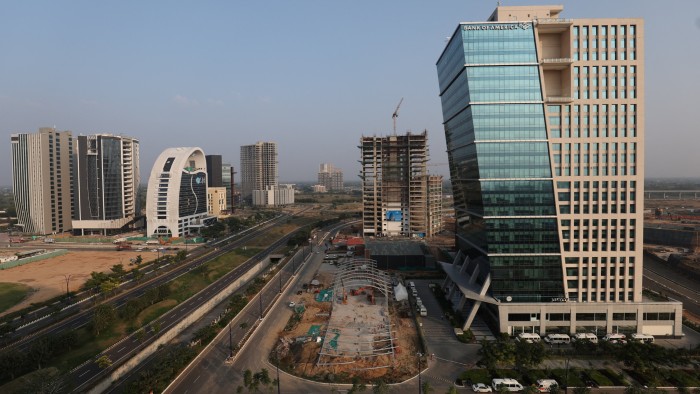
Unlock the Editor’s Digest for free
Roula Khalaf, Editor of the FT, selects her favourite stories in this weekly newsletter.
Standing on his office balcony in India’s searing afternoon heat, veteran civil servant K Rajaraman gestures across a panoramic sweep of cranes. They tower over the skeletal structures of tower blocks and a nearly finished metro system. This 886-acre work-in-progress is Gujarat International Finance Tec-City — also known as GIFT City — India’s most ambitiously business-friendly project to date.
Fast-talking Rajaraman, who heads the regulator that oversees the onshore tax haven, recently returned from the US where he was drumming up more investment. International interest, he says, is “proof of the pudding” that it will be a success. The number of organisations flocking to the city — a long-standing pet project of Prime Minister Narendra Modi and created in his home state — already exceeds 700.
This is even more impressive given GIFT City’s location in one of India’s few dry states. It is a world away from the choked up chaos and energetic drive of cosmopolitan financial capital Mumbai, with its beery taprooms and fine dining.
Gujarat, which juts out into the sea in north-west India, is not on most tourist to-do lists — though it contains a national park in the south that is the last known natural habitat of the Asiatic lion. The state is largely a vast, alluvial plain with some low mountains. It is considered conservative and business focused.
Fittingly, GIFT city, which sits on the banks of the Sabarmati River in a flat and dusty landscape, offers something more pragmatic than Mumbai’s buzzing nightlife. As a special economic zone, it avoids India’s onerous red tape and strict capital controls, while granting 100 per cent tax exemptions over 10 of 15 years. Those sweeteners have lured businesses from JPMorgan to HSBC as well as Australian universities, insurance houses, ship leasers and local tech titans Infosys and Wipro.
Already, it is rising up the Global Financial Centres Index, which ranks competitiveness in over hundred hubs, from 92 three years ago to 52. That places it ahead of Mumbai.
“It’s Modi’s baby and allows his administration to say they are opening up,” said one western diplomat who has visited. Still, they pointed out that some foreign businesses were shying away because the city is in “the middle of nowhere”. “Are top investment bankers going to relocate there with limited nightlife and a few mid-range hotels?” they added.
Although more than 20,000 employees already work here, the area remains eerily quiet. Well paved roads carry little traffic. Entertainment options have been slow to arrive. “It’s a chicken and egg situation,” said an executive who has set up a new office in the city. He estimates it will take at least five years for the city’s social element to liven up.
There have already been some compromises over Gujarat’s prohibitive laws. Late last year the state government published guidelines that in theory allow the sale of alcohol in parts of the city. However this message has not reached everyone. The staff at one hotel with a supposed liquor licence looked puzzled by my thirsty enquiries.
A fund manager preparing to set up shop here compares the district’s early days to those of Dubai, another arid and previously alcohol-free financial hotspot. “Dubai initially was not very open to that,” they said, acknowledging that good staffing would remain a “challenge”. “We have a massive operation in Mumbai, so there’s going to be a ton of support out of there initially.”
The long-term political viability of GIFT City has also come into question after a weakened Modi returned to power following a worse than expected electoral showing earlier in the year. Now beholden to coalition parties during his third term, some observers wonder if the project will survive should India’s opposition eventually come back to power.
Rajaraman brushes aside such concerns, calling the economic transformation across the country “unstoppable” and the new city’s growth a key part of that drive. No matter who has been in power, he says, “the Indian reform story has been continuous for decades”.

